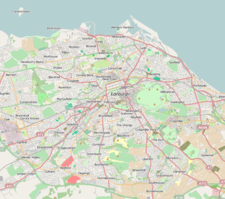|
Royal Edinburgh Hospital
The Royal Edinburgh Hospital is a psychiatric hospital in Morningside Place, Edinburgh, Scotland. It is managed by NHS Lothian.[1] HistoryThe "foundational myth" has it that the hospital was founded by Dr Andrew Duncan, following the death of Robert Fergusson, a Scottish poet who died in 1774 following mental health problems caused by a head injury.[2] Duncan wanted to establish a hospital in Edinburgh that would care for the mentally ill of the city and after launching an appeal in 1792 a grant of £2,000 was approved by Parliament in 1806.[2] A royal charter was granted by King George III in 1807 and the facility was then established as a public body.[3] A villa in Morningside, along with four acres of land, was then purchased and in 1809 the foundation stone was laid[4] by Lord Provost William Coulter on 8 June 1809.[5] The facility was opened as the Edinburgh Lunatic Asylum in 1813.[6] The asylum originally consisted of a building called East House which accepted only paying patients, but a second building called West House, designed by William Burn and commissioned to intended to accommodate poorer patients, opened in 1842.[7] The inmates of Edinburgh's bedlam were later admitted in 1844.[8] The asylum's first Physician Superintendent Dr William MacKinnon, who took up the post in 1840,[9] encouraged patients to be active through skills and hobbies they already possessed, including gardening, pig farming, carpentry, sewing, tailoring, poultry keeping, and curling.[8][7] Shortly thereafter, in 1845, the asylum installed a printing press and the hospital began to produce a monthly magazine, the Morningside Mirror.[7] The hospital received Royal Patronage in 1841 and became the Royal Edinburgh Lunatic Asylum.[10] The hospital joined the National Health Service in 1948 and the Andrew Duncan Clinic opened in 1965.[11] A 15 tonne work known as Abraham was carved in granite by sculptor Ronald Rae in the grounds of the hospital in 1982[12] and the Rivers Centre, a clinic for the treatment of Posttraumatic stress disorder established in memory of the pioneering psychiatrist William Rivers, opened in 1997.[13] A modern hospital on the same site was procured under the Scottish government's non-profit distributing model in January 2015.[14][15] The first phase of the new hospital was built by Morrison Construction at a cost of £45 million and completed in January 2017.[16] Pinel Memorial The Pinel Memorial was erected in 1926 to commemorate the centenary of the death of Philippe Pinel, a pioneer of psychiatric care. It includes six bronze medallion heads to other principal figures in improving conditions: William Tuke, Florence Nightingale, Robert Gardiner Hill, Andrew Duncan, Dorothea Lynde Dix and Campbell Clark.[17] Notable staffNotable staff have included:
References
External links |
||||||||||||||||||||||||||||

